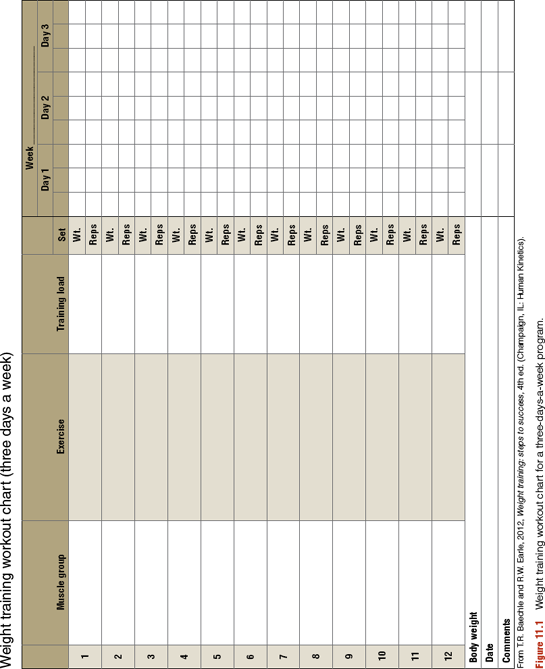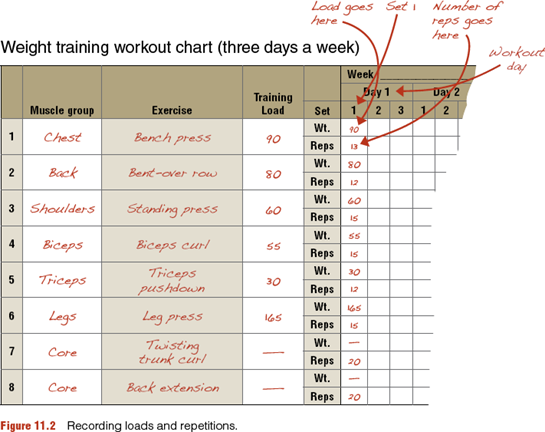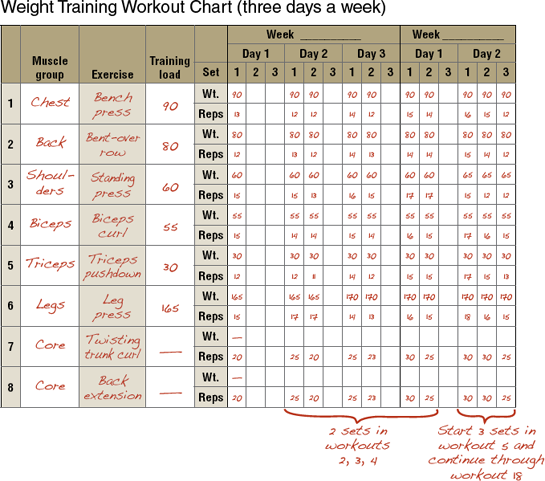
Now the fun really begins because this is when you start training! This step takes you through a series of tasks that are necessary to complete your first workout and to make appropriate changes in the ones that follow. Each workout should contain three parts: a proper warm-up, at least one exercise for each of the seven muscle groups addressed in steps 4 through 9, and a proper cool-down. (It is assumed that you are just starting a weight training program and are not yet trained enough to perform one of the total-body exercises from step 10.)
Completing this step results in a well-balanced basic program that gets you started on a training schedule. You don’t have to worry about other exercises to include, in which order to do them, how many repetitions to perform or sets to complete, or when to make load changes—these decisions have already been made for you. You should follow this basic program for at least six weeks before changing or customizing it in any way. It is designed to slowly improve your muscular fitness and give your body time to adapt to the new demands being placed on it.
By this point, you should have filled out much of the information needed for the workout chart (see figure 11.1). You should have selected an exercise for each of the seven muscle groups and determined a training load for each exercise. This is your basic program; in this step, you will use it to begin your journey to muscular fitness.
Make six copies of the workout chart to record your basic program results for six weeks. The drills at the end of this step will help you determine when and how to make needed changes to your workouts. Remember to properly warm up before each workout and cool down afterward.
For maximum benefits, make a commitment to train three times a week and allow yourself one day of rest between workouts. For example, try a Monday/Wednesday/Friday or a Tuesday/Thursday/Saturday schedule. If you can train only twice a week, allow no more than three days between sessions—a Monday/Thursday, Tuesday/Saturday, or Wednesday/Sunday regime. With consistent training, you will notice that as your muscular fitness improves, so will your ability to recover from the fatigue of each set and each workout.
The basic program begins with one set of 12 to 15 repetitions for the first workout, two sets of 12 to 15 repetitions for workouts 2 through 4, and three sets of 12 to 15 repetitions for workouts 5 through 18. The strategy is that the first four workouts will provide an appropriate level of initial stress to prepare your body for the more strenuous workouts to follow.
Pay attention to the length of the rest periods between sets and exercises; try to be consistent. The recovery time between each set and exercise should be 1 minute until workout 5, when you can consider shortening it to 45 or 30 seconds. Shortening the rest period will not only improve your level of muscular endurance, it also reduces the amount of time needed to complete a workout. The concern, however, is that if you do not rest long enough, you will not be able to complete the targeted number of repetitions. The result would be that you do not accomplish what you set out to do—which is to perform more repetitions of each exercise.
When you are able to perform two or more repetitions above the intended number (17 or more) in the last set on two consecutive training days (the two-for-two rule), it is time to increase the load. If you are unable to perform 12 repetitions in two consecutive training sessions, you need to decrease the load. Refer to the load adjustment chart shown in table 11.1 and make appropriate changes to the load.
Table 11.1 Load Adjustments
| Repetitions completed | Adjustment (pounds) |
| ≤ 7 | -15 |
| 8-9 | -10 |
| 10-11 | -5 |
| 16-17 | +5 |
| 18-19 | +10 |
| ≥ 20 | +15 |
Keep in mind two very important points while training. First, all repetitions should be performed with excellent technique—do not sacrifice technique for additional repetitions. The quality of the technique used to perform each repetition is more important than the number of repetitions performed. Give each repetition in each set your best effort and apply the two-for-two rule to keep the number of repetitions in each set between 12 and 15.
Charting Your Program Drill 1. Workout 1
For your first workout, perform one set of each exercise in the order listed on your workout chart. If the training loads are correct, you should be able to perform 12 to 15 repetitions in each set; if not, make adjustments as described in practice procedure 5 in step 3 (see pages 37-38). On your workout chart, record the completed number of repetitions in each set under the heading “Day 1.” Figure 11.2 illustrates where to write in loads and repetitions performed. After completing an exercise set, rest approximately 1 minute before starting the next exercise.
If you select any of the *additional exercises included in steps 4 through 9, remember to write them on the workout chart immediately after the basic exercise selected for that step.
Success Check
Check that you are using the correct loads.
Be sure that all of the bars are loaded evenly.
Secure the weight plates on the bars and selection keys in the weight stacks.
Use proper exercise and, if necessary, spotting techniques.
Make appropriate load adjustments, if necessary.

Charting Your Program Drill 2.
Workouts 2 Through 4
If you are training with a partner, arrange your workouts so that you take turns performing an exercise until both of you have completed the desired number of sets. For workouts 2 through 4, perform two sets of each of the exercises in the order listed on your workout chart. Again, if the training loads are correct, you should be able to perform 12 to 15 repetitions in a set. If not, you will need to make adjustments as described in practice procedure 5 in step 3 (see pages 37-38).
After completing an exercise set, rest 1 minute before starting the next set. On your workout chart, record the repetitions and sets you completed in the proper boxes. See figure 11.3 for an example of how to record your repetitions and sets for workouts 2 through 4. Complete drill 3 for workouts 5 through 18.
Success Check
Monitor your rest periods between sets and exercises.
Use proper exercise and spotting techniques.

Charting Your Program Drill 3.
Workouts 5 Through 18
Starting at workout 5, perform three sets of each exercise. The challenge is to keep the loads heavy or light enough so that you can perform 12 to 15 repetitions with excellent technique. Ask your training partner to use the numbered technique points in steps 4 through 9 to evaluate your technique and provide feedback. Be especially concerned with breathing and controlling the speed of movement throughout the range of each exercise. Consider shortening the rest periods between sets and exercises to 45 or possibly even 30 seconds.
Record all three sets on your workout chart. Use table 11.2 to determine when and how to make changes to your program.
Success Check
Focus on the quality of exercise technique rather than the number of repetitions you perform.
Apply the two-for-two rule to keep repetitions between 12 and 15 in each set.
Table 11.2 Making Workout Changes
| Variable | Workouts 2-4 | Workouts 5-18 | |
| Repetitions | 12-15 | 12-15 | |
| Sets | 2 sets | 3 sets | |
| Rest period length | 60 seconds | 30-45 seconds | |
| Load | Continue to make changes in the loads so that they are heavy or light enough to produce 12-15 repetitions. | ||
In this step you learned how to transfer the exercises you selected for your program to the workout sheet to begin training. You also learned how to record training information on your workout sheet. Keep recording this information in the weeks ahead—you will be impressed when you see your progress!
When you complete workout 18, which will be in six weeks if you are working out three days a week, you should modify your program. To learn how, read and complete the tasks described in steps 12, 13, and 14. These steps describe how you can change your program so that it continues to meet your needs and stimulate ongoing improvement.
Before Taking the Next Step
Honestly answer each of the following questions. If you answer yes to all of them, you are ready to move on to step 12.
1. Have you completed 18 workouts using your basic program?
2. Have you recorded your workouts on your workout chart?
3. Do you know how to modify loads so that you can complete 12 to 15 repetitions for each exercise?